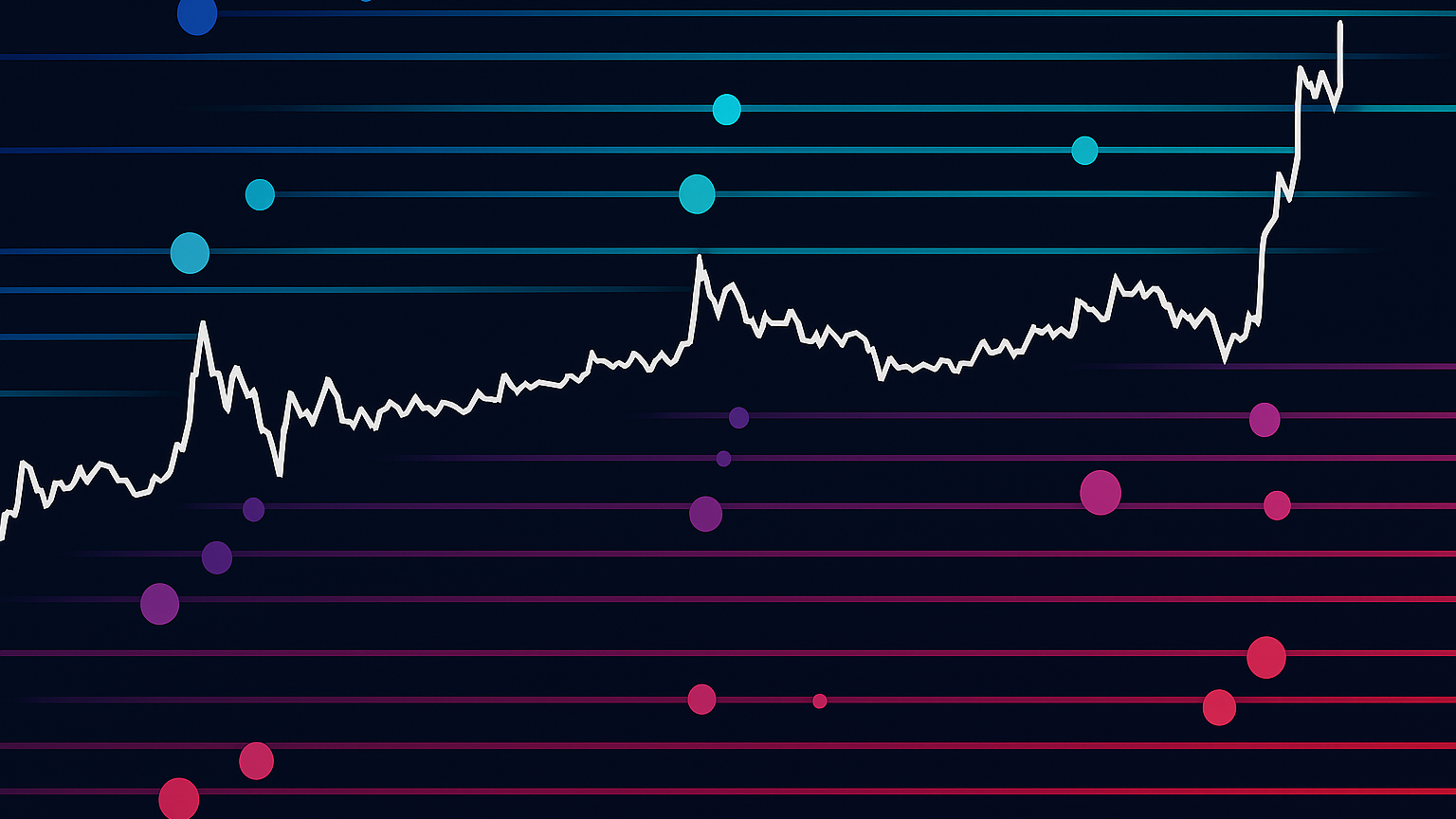Explore the essential concepts of support and resistance in trading, including techniques for identifying key price levels and strategies for successful trading.
Support and resistance are essential concepts in trading, marking price levels where buying or selling pressures dominate. These levels help traders:
- Spot Entry Points: Buy near support or sell near resistance.
- Manage Risk: Place stop-loss orders beyond these levels.
- Analyze Trends: Identify reversals or trend continuations.
- Set Price Targets: Use the distance between levels for profit planning.
Key types include static levels (e.g., round numbers, previous highs/lows) and moving levels (e.g., moving averages, trendlines). Techniques such as Fibonacci retracements, volume analysis, and chart patterns (e.g., double tops) further enhance accuracy. When breached, support often turns into resistance and vice versa.
For actionable methods and strategies, explore breakout trading, false breakout detection, and advanced features provided by LuxAlgo or market depth analysis.
Master Support & Resistance Levels
2 Main Types of Price Levels
Support and resistance levels can be grouped into two main types: static and moving price levels. Knowing how each works and when to use them can make a big difference in trading decisions.
Static Price Levels
Static levels are horizontal zones that stay fixed and often act as psychological barriers in the market. For example, Bitcoin's $20,000 level was a support zone in 2021 but turned into resistance after June 2022 [4].
These levels typically form due to:
- Previous highs and lows: Points where the price has reversed in the past.
- Round numbers: Whole numbers like $50 or $100 that traders often focus on.
- Gap zones: Areas where price gaps remain unfilled, creating support or resistance.
- Fibonacci retracements: Popular technical analysis tool for identifying potential turning points.
Moving Price Levels
Moving price levels shift with the market, adjusting as price action changes. These are especially useful in trending markets where static levels might lose their relevance.
A good example is the S&P 500's 200-day moving average. In 2023, the index repeatedly found support at this moving average [5].
| Level Type | Best Used For | Tools |
|---|---|---|
| Static | Range-bound markets | Historical price points, Round numbers, Gap zones |
| Moving | Trending markets | Moving averages, Trendlines, Bollinger Bands |
There's a 57.2% chance of market reversals at these levels [7]. When static and moving levels overlap, they create stronger reversal zones [2]. This combination is key for refining entry and exit strategies, as well as managing risk.
These two types of price levels lay the foundation for identifying actionable trading opportunities, which we’ll dive into next with practical detection methods.
Finding Key Price Levels
Pinpointing reliable support and resistance levels involves using a mix of techniques and tools. Here's a closer look at strategies traders rely on to identify these critical zones.
Price Pattern Analysis
Certain chart patterns can reveal where support and resistance levels may form. For example, double tops and bottoms occur when the price hits a specific level twice and reverses direction. These patterns often signal possible turning points, helping traders decide when to enter or exit trades.
Another key pattern is the head and shoulders. This setup features three peaks, with the middle one being the highest, and a "neckline" that serves as a crucial level. The neckline often acts as a strong support or resistance point, providing traders with actionable insights.
Technical Tools and Indicators
Technical tools can further refine your analysis of key price levels. One powerful method is volume profile analysis, which highlights areas where trading activity is most concentrated. The Point of Control (POC) – the level with the highest trading volume – often marks an important support or resistance zone.
Another useful method is Fibonacci retracements, which focus on levels like 23.6%, 38.2%, 50%, and 61.8%. These percentages often align with reversal points, especially when combined with volume clusters. For instance, the S&P 500 in 2023 demonstrated clear reactions at the 61.8% retracement level. Pairing Fibonacci levels with volume data can make these signals even more reliable.
Timeframe Analysis Methods
Begin your analysis on monthly charts to identify major support and resistance zones. Then, zoom into smaller timeframes for more precise trade entries. Using multiple timeframes helps filter out false signals and ensures your stop-loss levels are well-placed.
These strategies lay the groundwork for effective trading decisions, which we'll delve into further in the next section.
Trading with Price Levels
Building on the identification methods from earlier sections, traders often rely on three main strategies when working with price levels:
Trading Price Ranges
Range trading focuses on price levels that have shown at least three reactions, as these are generally more dependable. For instance, if the EUR/USD forms a daily range with support at 1.0800 and resistance at 1.1000, traders might look to go long near the support level, placing stop-losses 20-30 pips below their entry point [2][4].
Breakout Trading Methods
Breakout trading requires patience and careful confirmation. The most reliable breakouts tend to meet specific criteria:
| Breakout Component | Key Requirements |
|---|---|
| Volume | More than 50% above the 20-day average |
| Price Close | Over 1% beyond the breakout level |
| Trend Alignment | Matches the direction of a higher timeframe trend |
A good example is gold’s 2023 breakout above $2,000 per ounce, which succeeded due to strong trading volume and alignment with the weekly trend [8][1].
Spotting False Breakouts
False breakouts are a common trap for less experienced traders. Low-volume breakouts are especially questionable, as valid breakouts generally require volume to exceed the 20-day average by at least 50%.
"A study by Adam Grimes found that breakouts occurring after a period of low volatility (at least 20 days) had a 62% success rate for stocks and 55% for forex" [6].
To avoid falling victim to false breakouts, consider these safeguards:
- Ensure volume is at least 50% above the 20-day average.
- Confirm that the price closes more than 1% beyond the breakout level.
- For upside breaks, check that RSI(14) is above 50.
These strategies provide a solid framework for identifying reliable setups and minimizing risks, setting the stage for more advanced analytical methods in the next section.
Advanced Price Level Tools
For professional traders, basic pattern recognition often isn't enough. Many turn to these advanced methods to refine their strategies:
LuxAlgo Platform Features
LuxAlgo’s Price Action Concepts (PAC) Toolkit elevates traditional static and moving levels by automating pattern detection and verification across multiple timeframes [2][9].
| Feature | Benefit |
|---|---|
| Multi-timeframe Detection | Confirms levels across various trading horizons |
| Order Cluster Alerts | Identifies upcoming supply/demand zones |
| Historical Validation | Assesses level reliability based on past reactions |
Market Depth Analysis
Market depth data offers a clear view of real-time supply and demand, helping traders gauge the strength of support and resistance zones. Unlike historical patterns, this data reveals active trading pressure at critical levels.
"A study by the Journal of Trading found that incorporating market depth data improved the accuracy of support and resistance predictions by 23% compared to traditional chart analysis alone" [3].
Key aspects to monitor in market depth include:
- Large order clusters that might act as price barriers.
- Imbalances in buy and sell orders.
- Real-time shifts in order flow as prices approach significant levels.
Testing Trading Results
Testing strategies with historical data ensures they perform as expected. This step is essential for confirming the price action methods outlined earlier.
| Metric | Minimum Requirement |
|---|---|
| Win Rate | 60% |
| Risk-Reward Ratio | 1.5:1 |
| Maximum Drawdown | Below 15% |
Conclusion
Main Points Review
Support and resistance are key concepts in technical analysis, representing areas where buyers and sellers push against each other. These levels gain importance when tested multiple times. Traders often evaluate them using methods like historical price data, moving averages, volume patterns, and real-time order flow [2][4].
By looking at different methods for identifying these levels and applying trading strategies, it’s clear that understanding both stable and shifting market behaviors is crucial [1][4]. This approach helps traders spot potential reversal points and uncover trading opportunities across different market scenarios.
Getting Started
Start by using daily charts to pinpoint major levels. From there, incorporate analysis across various timeframes and test strategies as detailed earlier [5]. Continuously refine your approach to stay in sync with changing market dynamics.
FAQs
How do you trade support and resistance successfully?
Here are two key steps:
- Validate levels: Use methods like volume analysis and indicators such as RSI or MACD to confirm the strength of the levels.
- Manage risk: Set stop-loss orders just beyond these levels to protect your trades.
For strategies tailored to specific timeframes, check out the Timeframe Analysis Methods section.
What is the best way to trade support and resistance?
Adapting to market conditions is crucial. Two common approaches include:
- Breakout trading: Enter trades when price breaks through a level, confirmed by strong volume.
- Pullback trading: Wait for the price to return to and hold at a previously broken level before entering.
What is the theory behind support and resistance?
Support represents areas where buying interest is strong enough to prevent prices from falling further. Resistance, on the other hand, marks zones where selling pressure outweighs buying. These levels often align with psychological price points, like round numbers [4][1].
How do you find the strongest support and resistance?
The most reliable levels often share these traits:
- Tested multiple times in the past
- Aligned with areas of high trading volume
- Supported by technical methods like Fibonacci retracements
- Confirmed across different timeframes
For more on validation methods, see the Advanced Price Level Tools section.






